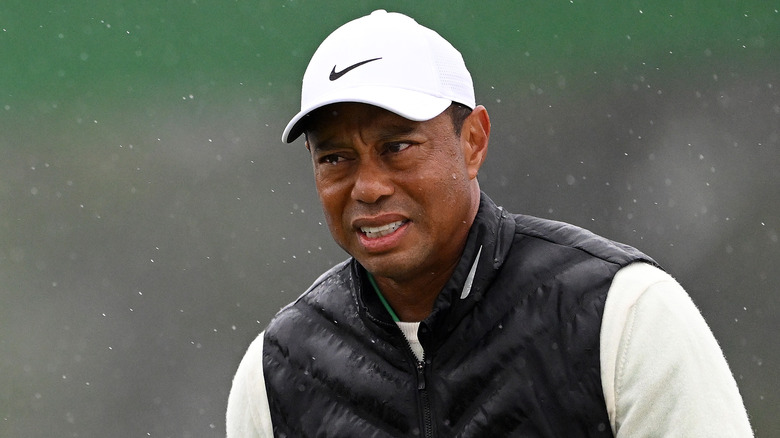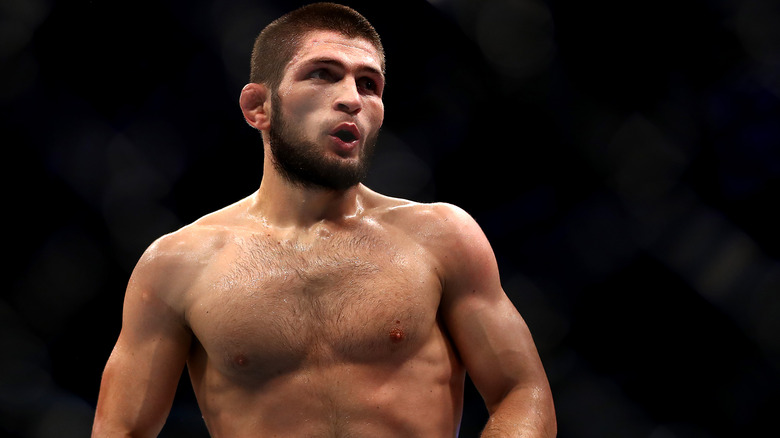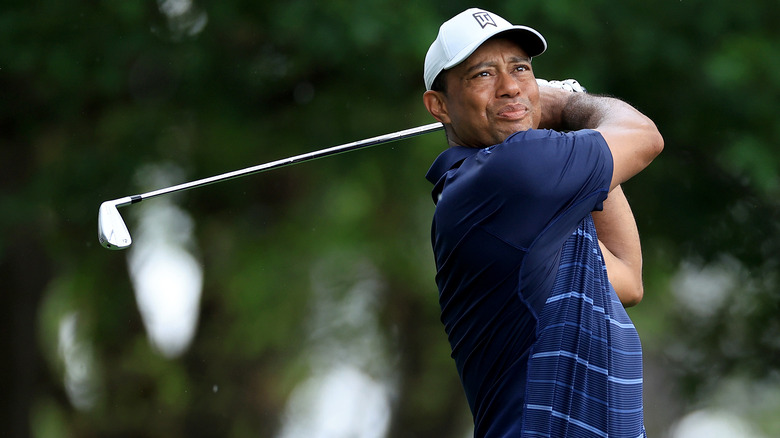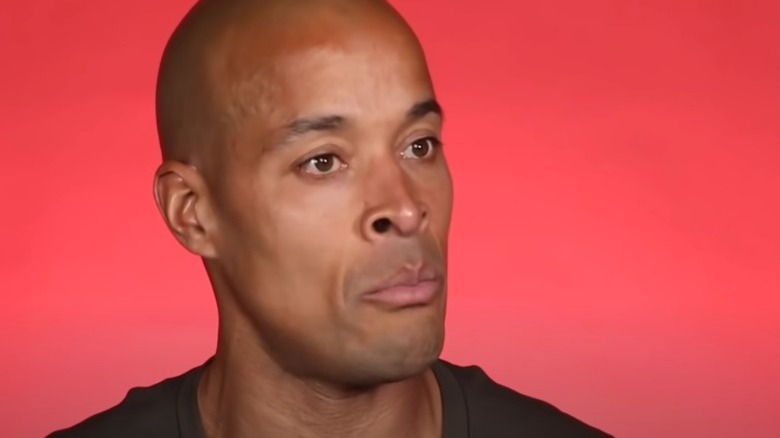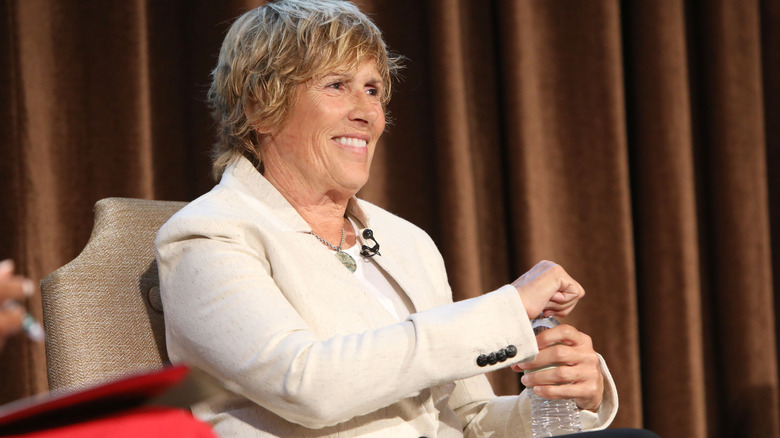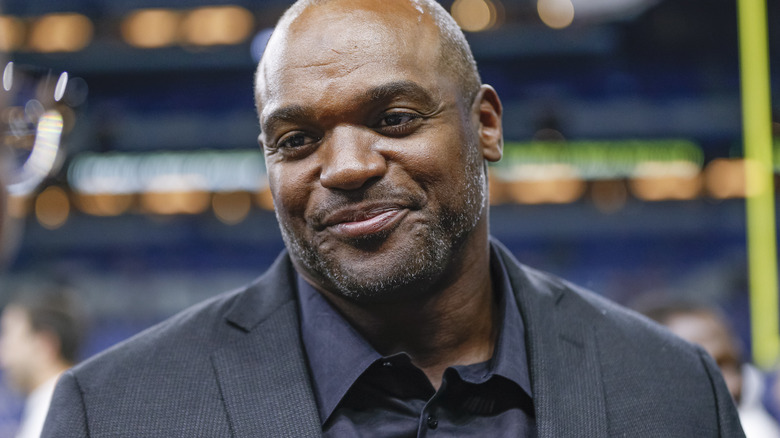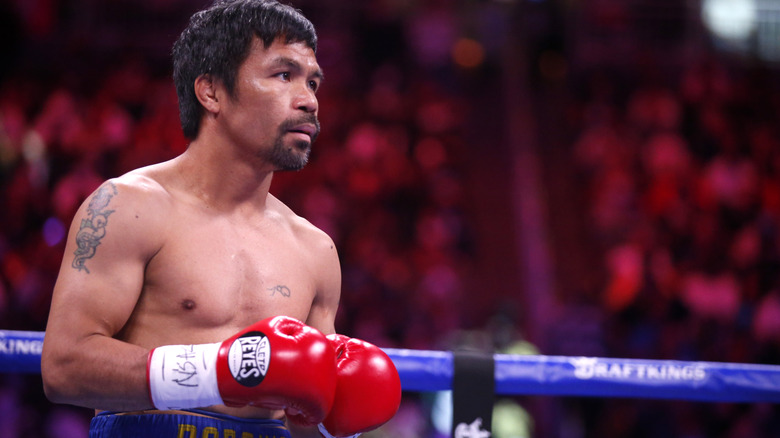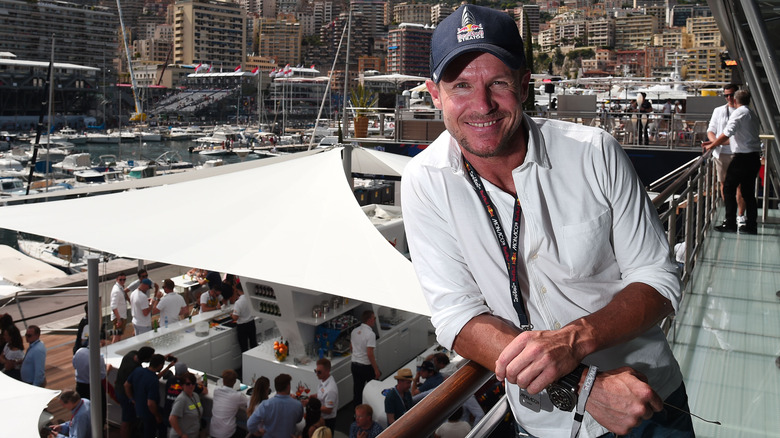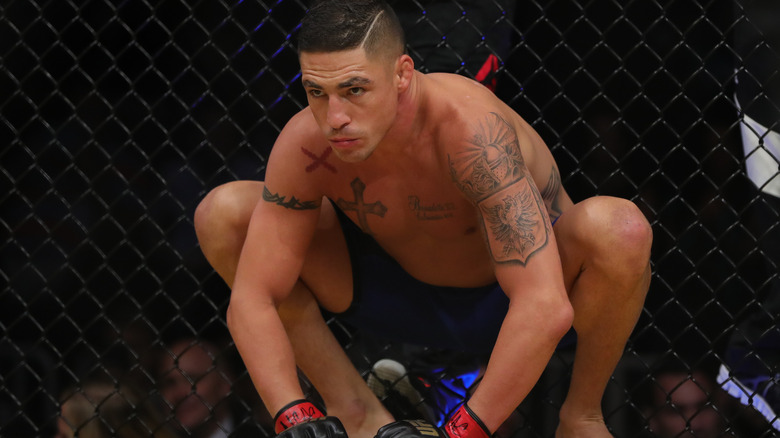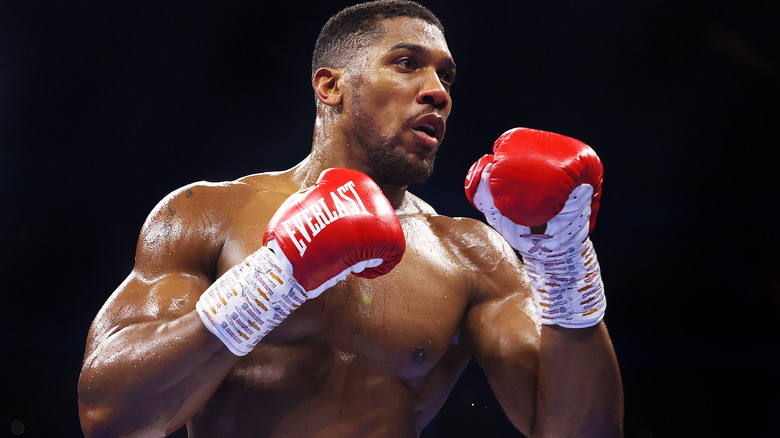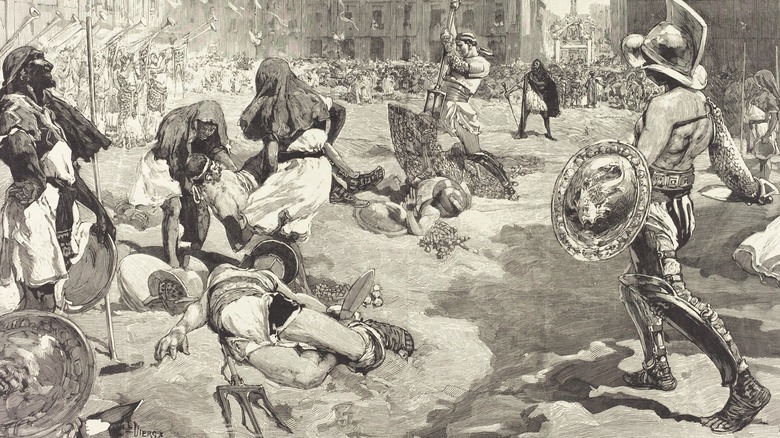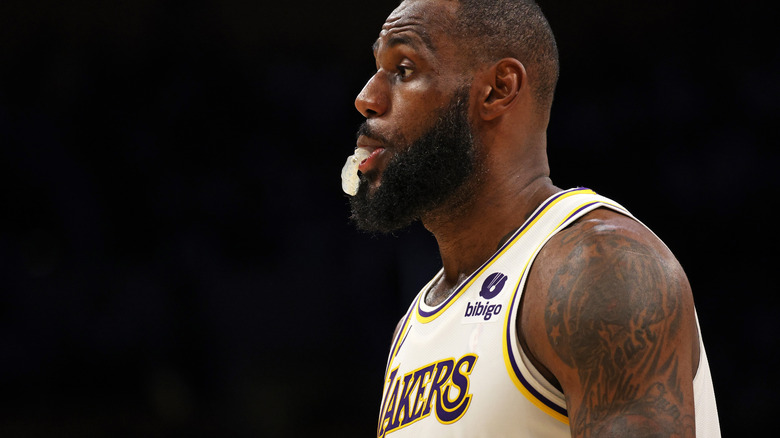The Most Intense Training Athletes Ever Went Through
Game day, match day, or race day is really just part of the story. It's all the culmination of some seriously intense training, designed to give those with innate athletic talent an extra advantage over their opponents. It's grueling stuff that most casual sports fans don't get to see much of, but when you take a glimpse behind the curtain, it's eye-opening stuff. From long hours in the gym to carefully curated meal plans, being an elite athlete is more than a full-time job.
And that's the thing, isn't it? There are always those people at every game day party who are convinced that if they were being paid the big bucks, they could absolutely go through that training and become a serious contender. Could they? Nah. Will they believe that? Probably not. But here's something that might help put things in perspective for them: For some of the world's top athletes, it's about much more than diet and hitting the gym.
Everyone does that, after all, and in order to get the real advantage, some athletes start thinking outside the box to go above and beyond. That leads to some intense training practices that would break mere mortals... so maybe it's not a matter of anyone being capable of it after all.
Khabib Nurmagomedov
Khabib Nurmagomedov was retired when he sat down with ESPN MMA to provide a pretty wild look into a pretty wild career. When he looked back on the long road he'd walked to get him where he was, he said that it had started when he was young. Under the watchful eye of his father (who perhaps had some questionable ideas about training methods), he started honing his skills against a massive opponent.
Was it a bear? Of course it was. "When I told him, 'Hey, this bear tried to bite me!' I remember when he told me, like, 'Bite him back. No problem. You have to wrestle. You have to keep going,'" Nurmagomedov recalled. According to what he told The Ring, he was 9 years old when he first decided he was going to start training by wrestling with a bear. In all fairness, it was a small bear that had been trained to wrestle. And it was on a chain, so there's that to consider, too... so, maybe animal-lovers should look away now.
Nurmagomedov was pretty low-key about the whole thing, going on to say that it had taught him to persevere in the face of opponents who might have seemed way out of his league — and obviously, it worked. Regrets? He doesn't have any: "I am very happy about all my journey," he told ESPN.
Tiger Woods
Everyone deals with grief differently, and about a month after Tiger Woods lost his father, he set off on an extreme training program that wasn't related to his sport, but to his loss. Before his father's death, Earl Woods had taken Tiger, who'd once dreamed of being a Navy SEAL, for a taste of his own history as a Green Beret. That came in the form of a trip to Fort Bragg and a tandem jump out of a plane. Fast-forward to 25 days after Earl's death, and that's when Tiger kicked off his training with the SEALs.
ESPN spoke with some of the SEALs he trained with, and instructor Petty Officer 1st Class John Brown explained what it had meant to Woods: "I definitely think he was searching for something. Most people have to live with their regrets. But he got to experience a taste of what might have been."
And experience it, he did. Running through the Kill House — a combat simulator where recruits hone their close-range skills and try not to kill civilians — was perhaps the easiest part of the training. (And yes, he did "kill" civilians.) There was solo skydiving, mock combat scenarios in the desert, and intense workouts that lasted through a series of visits in 2006 and 2007. What did the SEALs think? One retired SEAL had this to say about Woods, after speaking with colleagues who'd trained with him: "His interactions with the guys were not always the most stellar, and most were very underwhelmed with him as a man."
David Goggins
David Goggins might not be a household name, and that brings up an important question: Why the heck isn't he? In addition to being one of the best ultra-endurance athletes to ever run some of the world's toughest races, he also holds some serious world records, including the most pull-ups done in 24 hours. He only needed 17 of those hours to do 4,030 pull-ups. So.
But he wasn't born a natural athlete. He decided to work for it, and that started with a three-month commitment to drop 100 pounds and get into good enough shape that he would be able to train with and become a Navy SEAL. It's worth noting, too, that he did it on just 800 carefully chosen calories a day. It was a far cry from where he'd started.
How'd he get there? Goggins says that he doesn't have a set plan, but on an ordinary day he starts with running 20 miles, then rides his bike another 20 miles to work. He fits in tons of time at the gym, and in a 2017 Facebook post, he looked back at the training he did to prep for his first ultra-marathon. That involved running around 100 miles a week, and let's not forget he's the only human being to complete not only SEAL training, but to go through Army Ranger School and the Air Force's Tactical Control Training.
Diana Nyad
In 2013, Diana Nyad became the first person to swim the 110 miles between Key West and Havana, Cuba, without a shark cage. It took her just a few minutes shy of 53 hours. She was 64 years old at the time, and coming off a 30-year break from the competitive swimming she used to do. Sounds impossible, right? Experts thought so.
So how did she do it? She started by hitting the pool at a local country club and swimming just around half an hour at a time. From there, she steadily increased the amount of time she spent in the water, until she was ready to try the real thing, in a 6.5-hour ocean swim off the coast of Mexico. Then, six-hour swims grew to 15-hour swims, and there's a pretty wild footnote that goes along with this.
According to ESPN, Nyad had to back off on her out-of-the-water training because she was putting on so much muscle mass that it was starting to become detrimental to swimming. All that came as a consequence of her 100's: 100 burpees a day and a 100-mile bike ride every week. Her mental training was just as important, and included teaching herself to count her strokes in different languages and replaying songs over and over in her mind. Just so she didn't get bored, she had memorized 85 of them.
Ancient Greek Olympians
The sheer amount of training equipment available to today's athletes means that every bit of the human body can be monitored and fine-tuned. That's great and all, but what about history's athletes? When the BBC did a deep dive into what information was available on how ancient Greek Olympians trained, what they found suggests that they had training workouts that would make any modern athlete struggle... and that's before even considering that ancient MMA fighting (or pankration) often ended when someone was either a) permanently disfigured or b) dead.
Information on training came from all over, with ancient texts and illustrations serving as the most valuable resources. Some things — like the use of weighted bags for punching and kicking — sound familiar today, while other methods are less so. Holding and controlling four horses at a time was a way wrestlers built up muscle mass, along with swimming — in full armor. The strongest of athletes would keep their muscles in tip-top shape by bending iron bars, and the fastest would train by running in sand. Honestly, it's no wonder people died in competition.
They died during training, too. One particular method called the tetrad dictated how athletes should spend their time and consisted of a punishing four-day cycle of short-burst exercises, maximum-effort workouts, rest, and moderate exercise — and yes, it was so grueling that it resulted in the death of at least one athlete.
Dwight Freeney
When Indianapolis Colts defensive end Dwight Freeney gave Sports Illustrated an inside look at his training equipment, he started off with a disclaimer: "I know it's weird. Everything I do is weird. I ask myself all the time, 'What the hell am I doing?'" In addition to the more standard fare, Freeney had his home set up with things like a hyperbaric chamber, a machine that channeled electrical currents directly into specific muscles, and another machine for laser therapy.
Physical workouts are just one aspect of training; a huge part of what makes athletes capable of their superhuman feats is their diet. And that's where Freeney gets beyond intense, as he follows something called Sari Mellman's Dietary Progression. The idea is that every so often, Freeney has blood drawn and analyzed to figure out what he needs to feed his body to get the results he wants. At the time he was interviewed, he was eating only beef and pinto beans, and drinking only water, grape juice, and tea.
The diet is wildly specific, and Freeney says it involves things like swapping out one type of protein for another, or eating — for example — Fuji apples only... and definitely no other variety of apple. Freeney told News on 6 that he was on the path of what he calls "dietary re-engineering," and he says everyone can do it.
Manny Pacquiao
When ESPN shadowed Manny Pacquiao on one of his training days, they found that he really loved every bit of it — even the 6.5-mile run, in an area of Los Angeles that allowed him to make most of that run uphill. When it's back to the gym, that's when things start to really get going... with 1,200 sit-ups.
This was in 2019, when Pacquiao's sparring partner was a boxer around 20 years younger then he was. Pacquiao was still pushing himself, secure in a safety net provided by his trainer in the form of a promise that if he saw signs that it was time to quit, he would say so. Meanwhile, those 1,200 sit-ups weren't even the most cringe-inducing thing he's put himself through to get to the very top of his game — and to stay there.
In 2021, Pacquiao posted a video to his Instagram, and it's basically him getting hit — very hard, very quickly, and many, many times — with a stick. The expression on his face suggests that it's even more painful than it might look, because if it makes him flinch, it's probably not something mere mortals can handle. He's used the stick-training method before, and the idea is to tone muscles, increase a person's tolerance for pain, and help the fighter learn to focus through that pain.
Felix Baumgartner
Felix Baumgartner made history when he stepped out of a perfectly fine capsule and plummeted to the Earth in a 24-mile-high skydive that had him hitting speeds of a shocking 833.9 mph. Why? Why not! The last words of the man who had coached him to that point were deceptively blasé: Ret. U.S. Air Force pilot Joseph Kittinger told him (via National Geographic), "Be sure to duck your head real low as you go out the door."
That's great advice, but that's not really training... and before he jumped, Baumgartner had to do plenty of that. According to Red Bull, most of his prep had been psychological. He had to wear a specially designed, pressurized suit, and no amount of skydiving had prepared him for the claustrophobia that came with it. It was so bad that the first time he found himself facing a period of five hours in the suit, he walked away from the entire thing.
What followed were weeks of training with a psychologist who put him in a series of situations designed to kick-start the panic he felt in the suit so he could learn to control it. Baumgartner and Dr. Michael Gervais trained to the point where he could focus through it, and it came in handy. When he jumped, he went into a spin at the rate of one revolution per second; stopping it saved his life. Baumgartner called it "controlling the devil."
Diego Sanchez
MMA fighter Diego Sanchez was nicknamed the Nightmare, but when videos of his training started getting posted around the internet, it started to seem like that was the actual nightmare. How over-the-top was it? In 2021, the UFC released Sanchez amid concerns that he had been suffering from some undiagnosed medical issues, and at the time, UFC president Dana White had this to say to Yahoo Sports about Sanchez's coach, Joshua Fabia: "The guy is bats*** nuts. He worked his way into Diego's life and has gotten control over him. I just want the best for Diego."
There were a couple videos floating around that showed just how intense Sanchez's training was, and when we say "intense," we mean that in a "I'm going to cut you" kind of way. In one video posted to Twitter, Fabia is in the ring with a group of fighters... only, he's armed with a knife, and he's slashing away at them while shouting at them to avoid the knife and assume everyone else has one, too.
In another video, Sanchez is suspended upside-down while Fabia slaps him in the head, punches him in the head and face repeatedly, steadies him, then starts kicking him. The footage showed up on YouTube and was reportedly pulled, and according to USA Today, it kicked off a series of accusations that flew between Sanchez, Fabia, and the UFC.
Anthony Joshua
Quick, what is it that rarely gets a workout, even for the most dedicated of athletes? Anyone who went with "teeth" would be correct, but in the case of Anthony Joshua, well, he's got those covered, too. In 2016, he tweeted a video of one of his neck, back, and shoulder workouts, and it involved putting a towel through the handles of two kettlebells, gripping the towel in his teeth, and lifting. Dentists everywhere cringed... and so did everyone else watching it.
Fast-forward to 2020, and Joshua was averaging 14 hours of training per day. In addition to running and cardio — often done in a sand pit to make it even harder — there were also exercises like throwing a weight at a target, picking it up, and throwing it again... rinse and repeat, with an 11-pound weight. There were also exercises he borrowed from the likes of Mike Tyson and Brazilian footballers (for the speed). And then there was the sparring.
That's about the same time he was working up to a bout against Oleksandr Usyk, and Joshua told The Daily Mail that he'd been working with Olympic coach Rob McCracken. What got added onto his day by this coach? He explained: "After I've sparred 12 rounds one day, then 15 the next, he's so good at getting me back in the ring and giving him another 10 rounds."
Roman gladiators
In 2014, archaeologists at the Ludwig Boltzmann Institute for Archaeological Prospection and Virtual Archaeology revealed (via National Geographic) what they found after using remote mapping techniques to explore the remains of a gladiatorial school near Vienna. It was pretty fascinating stuff.
The facility was home to around 80 gladiators, who had access to training facilities, indoor plumbing, and heated floors that made training through the winter months possible. There was also a graveyard... so, there's that. But the researchers pointed out that the enslaved fighters were considered valuable — so most of the time, it was about putting on a show, not slaughtering each other. Most of the time.
University of Western Ontario classical studies professor Nigel B. Crowther gives a little more insight into what their training was like (via InsideHook), and says that it was likely more like military training than, say, the training of a modern-day boxer. Most would have trained with their weapons of choice — while wearing armor — and exercised with things like stone weights. Practical exercises such as dragging weights would have been the norm on training days for gladiators. Diet, too, would have been a crucial part of their training, and the discovery that they were largely vegetarian actually makes sense: There's a theory that a carb-heavy diet would allow gladiators to build up a layer of fat that would act as a bit of protection against a slicing sword swing.
LeBron James
Training covers a lot — it's not just the grueling exercise, but it's also the recovery methods used to allow players to get up the next morning and do it all over again. And that's where "Terminator 2" comes in. Well, sort of. Remember the scene with the liquid nitrogen? Seems like that's probably something no one would voluntarily do in real life, right?
Not so fast: According to HoopsHype, part of LeBron James's self-care routine (which costs him a total of around $1.5 million a year) involves cryotherapy, which basically means donning some gloves and heavy socks, then spending a few minutes in a chamber that lowers the temperature to -250 degrees Fahrenheit. Does that sound wrong? That sounds wrong... but it's not. The idea is that it helps repair muscles damaged by hardcore workouts in a few different ways, including reducing inflammation. James isn't the only believer, and more and more NBA players are doing it.
But should they? The Food and Drug Administration says that cryotherapy might just be as questionable as it sounds. They note that research is far from complete and scientific data is still lacking, but also that there's a whole bunch of perhaps unsurprising risks associated with the treatment. Besides frostbite and burns, there's also the potential for a loss of consciousness and oxygen deficiency stemming from the use of the nitrogen gas.
